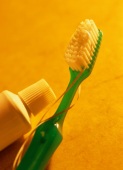
TUESDAY, May 6, 2014 (HealthDay News) — Primary care doctors should start playing a more prominent role in dental care for children, according to new recommendations from the influential U.S. Preventive Services Task Force.
Specifically, the task force suggested Monday that primary care physicians prescribe oral fluoride supplementation, such as drops, tablets or lozenges, for children 6 months and older whose water supply doesn’t have enough fluoride.
“In addition, we are recommending that infants and children should have fluoride varnish applied to their teeth when baby teeth appear, and that primary care clinicians can do that,” said task force chairman Dr. Michael LeFevre.
“That should be a part of routine well-child care,” he added.
LeFevre said that while some primary care doctors are already doing that, most of them aren’t. “It’s not something most parents would expect from a well-child visit, and it’s not something that most primary care providers are including in well-child visits,” he said.
Most doctors incorrectly assume that children are seeing a dentist, LeFevre said. “The problem is that three out of four preschool-aged kids do not visit a dentist,” he added.
But most children do see a primary care doctor, he noted. “So, there is a missed opportunity here for a significant number of kids who could benefit, in terms of preventing tooth decay,” he said.
Tooth decay is a significant health problem for children, LeFevre noted. “Applying fluoride varnish is something that primary care clinicians can do. It’s not complicated and this is a way primary care physicians can help the dentist in terms of preventing tooth decay,” he said.
Fluoride varnish should be applied whether the local water supply has sufficient fluoride or not, LeFevre said. “Studies show that application of the varnish, even when the water is fluoridated, helps to prevent tooth decay,” he said.
LeFevre believes parents should be asking their primary care doctor to coat their children’s teeth with fluoride.
According to the task force, even very young children can develop tooth decay. Almost half of children aged 2 to 11 have cavities in their baby teeth, they noted.
The task force is an independent panel of experts that researches and makes recommendations on preventive health care. Their newest recommendations, which were published online May 5 in Pediatrics, are in concert with guidelines issued by the American Dental Association (ADA) last February.
The updated ADA guidelines state that children should begin using toothpaste with fluoride as soon as they get their first tooth. Before that, parents had been told to use water to brush the teeth of children younger than 2 and to use a pea-sized amount of toothpaste for children aged 2 to 6.
Dr. Rosie Roldan, director of the Pediatric Dental Center at Miami Children’s Hospital, said these recommendations are fine as long as they are part of overall dental care, which includes referrals to a dentist.
Parents look for guidance from their doctor, she noted, but doctors should be referring them to a dentist.
“Application of fluoride just for the sake of doing it doesn’t do anybody any good. If the pediatrician understands the process of getting the child to a dentist, then applying fluoride is a good idea,” Roldan said. “This can get the patient some preventive care until they can get to a dentist.”
According to the task force, there is not enough evidence to say whether regular screening for tooth decay in children aged 5 and younger will improve their future health. So the task force is not able to recommend for or against such screening.
More information
Visit the U.S. National Library of Medicine for more on children’s dental health.
Copyright © 2025 HealthDay. All rights reserved.

